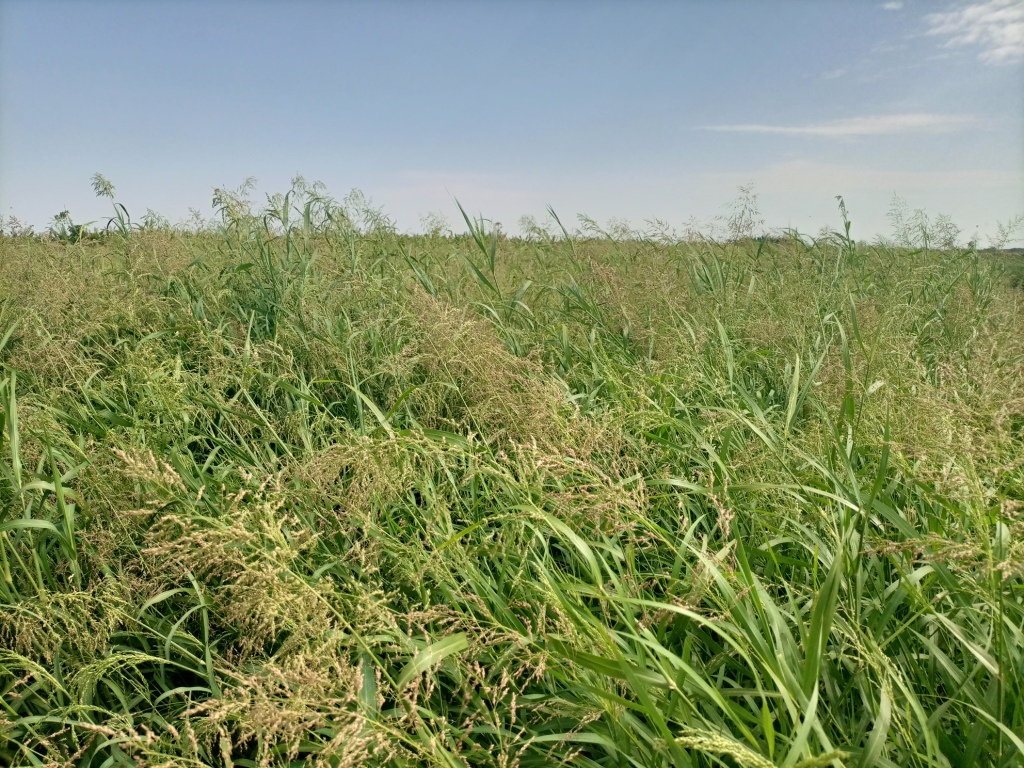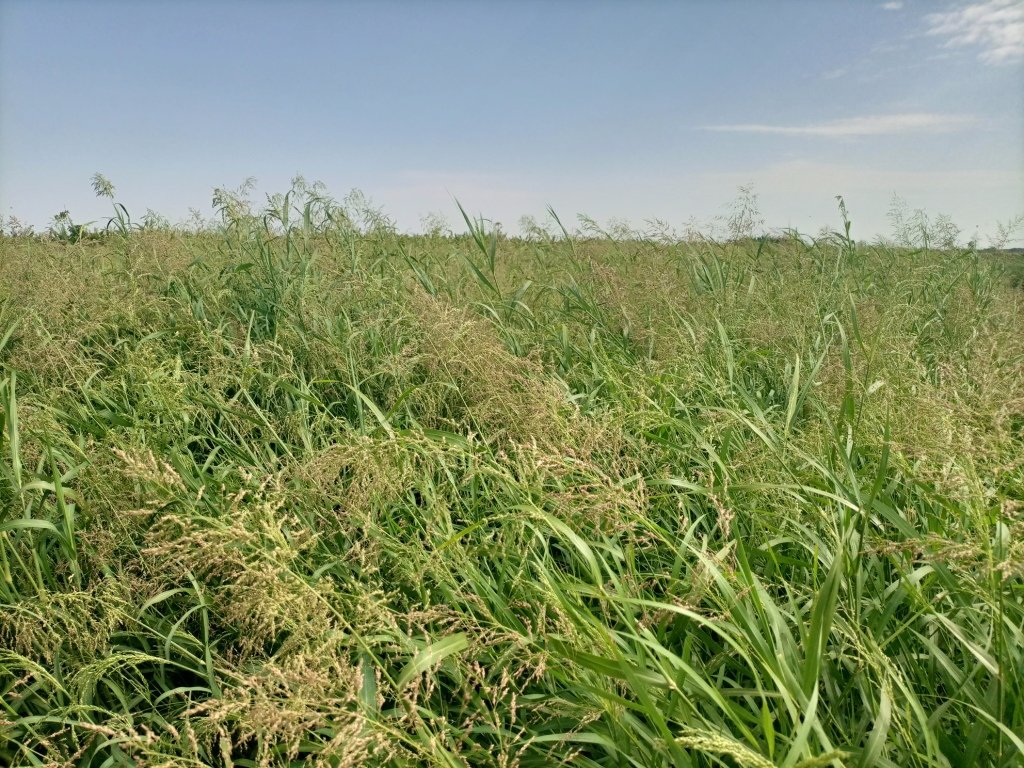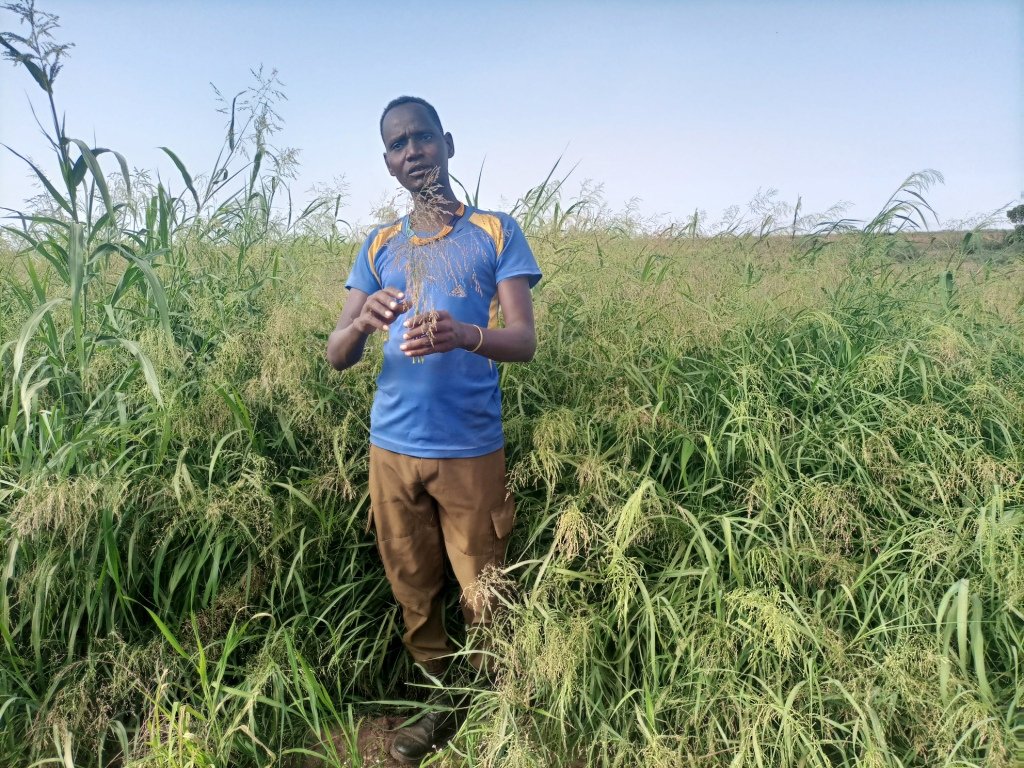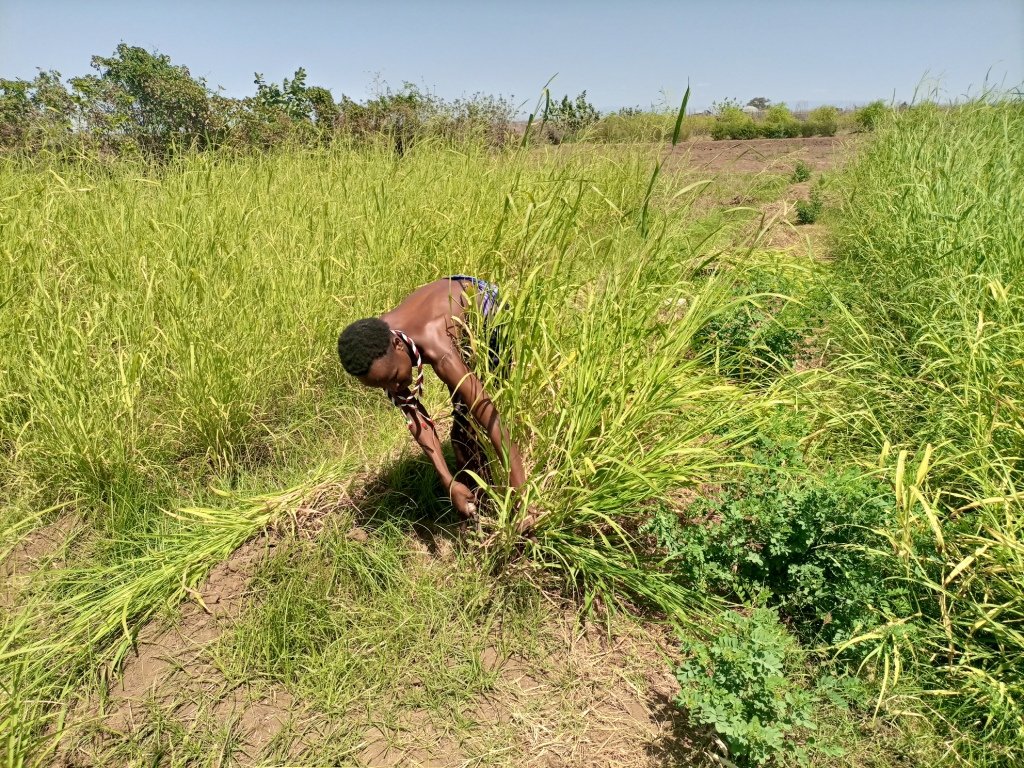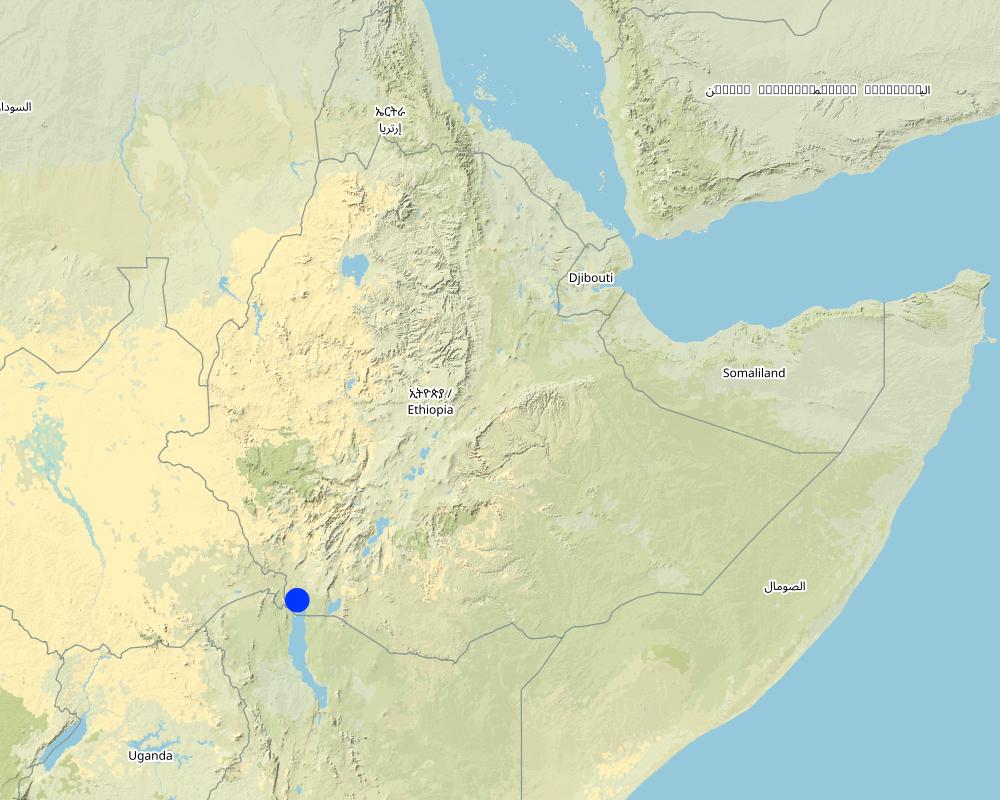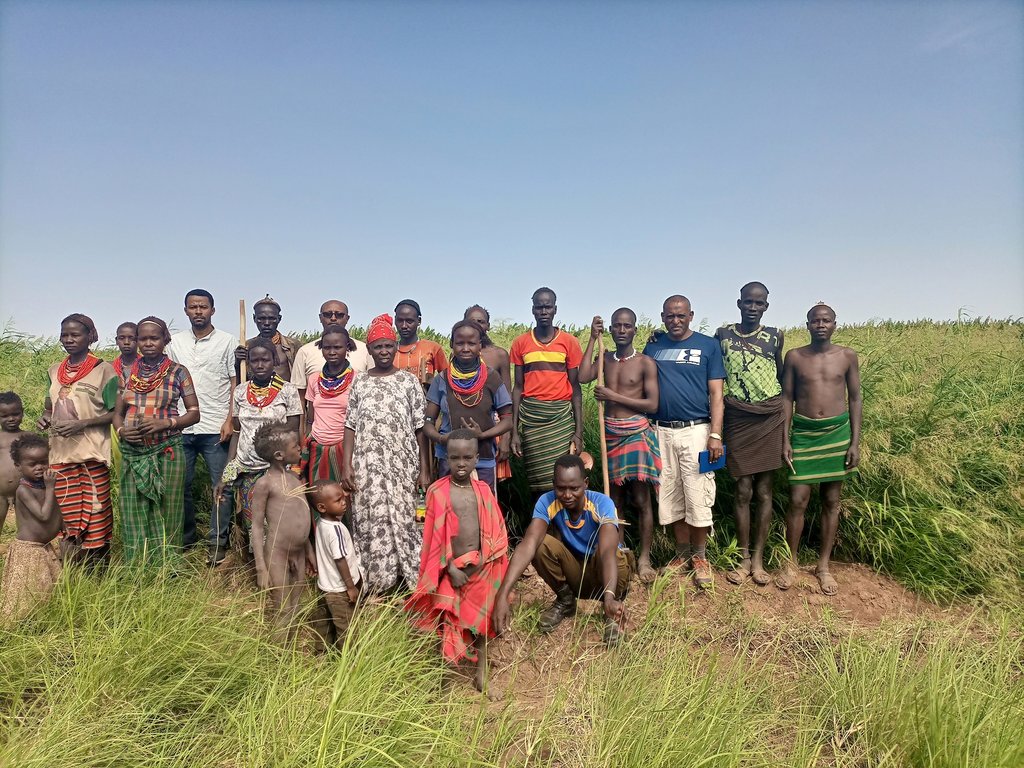Panicum coloratum for irrigated fodder [Ethiopia]
- Creation:
- Update:
- Compiler: GERBA LETA
- Editor: –
- Reviewers: Rima Mekdaschi Studer, William Critchley
Panicum
technologies_6563 - Ethiopia
View sections
Expand all Collapse all1. General information
1.2 Contact details of resource persons and institutions involved in the assessment and documentation of the Technology
Key resource person(s)
land user:
Lutulya Abebe
Agro-pastoralist (fodder producers group leader)
Ethiopia
Name of project which facilitated the documentation/ evaluation of the Technology (if relevant)
Resilient in Pastoralist Areas (RIPA)Name of the institution(s) which facilitated the documentation/ evaluation of the Technology (if relevant)
International Development Enterprises - Ethiopia (iDE-Ethiopia) - United States1.3 Conditions regarding the use of data documented through WOCAT
The compiler and key resource person(s) accept the conditions regarding the use of data documented through WOCAT:
Yes
1.4 Declaration on sustainability of the described Technology
Is the Technology described here problematic with regard to land degradation, so that it cannot be declared a sustainable land management technology?
No
Comments:
The technology is a regenerative practice friendly to the environment.
2. Description of the SLM Technology
2.1 Short description of the Technology
Definition of the Technology:
Panicum coloratum is a palatable tropical grass with high biomass production potential. It is grown in the irrigated fodder development areas of Dassenech district. Panicum is a fast-growing perennial which can be repeatedly harvested once it reaches maturity. It mitigates the issues of recurrent livestock feed shortage in dry periods – which are becoming worse with climate change.
2.2 Detailed description of the Technology
Description:
Irrigated fodder production is carried out by pastoralist groups in arid areas of South Omo. Among a number of fodder grasses, Panicum coloratum is a fast-growing species. Panicum is grown as livestock fodder, particularly for the dry season when feed availability is in short supply. It mitigates the issues of recurrent livestock feed shortages which are becoming worse with climate change. Also, growing fodder grass allows resource-poor pastoralist communities to generate income from the sale of fresh fodder, hay, and seed. Irrigating at least twice a week, good weed management, and fertilization ensure sustained production.
In Dassenech district of Southwest Ethiopia, Panicum’s annual fresh biomass and dry matter production potential is over 63 and 18 tons/ha, respectively. It can reach its first harvest after about 60 days and subsequently can be harvested every 45 days. Panicum germinates and establishes readily on any soil type under both irrigated and rainfed conditions. It is also drought tolerant and resilient to climate variability, and does particularly well on alluvial soils with high fertility. Panicum is mainly used for grazing, but it is also suitable for cut-and-carry feeding systems. Each member of the pastoralist group grows panicum on 0.04 ha of land. In the flood lowlands of the Omo River basin, panicum is known for tolerating periodic flooding, salinity, & disease.
Previously, the land users were unfamiliar with this particular grass and its associated management practices. Also, irrigating on a regular schedule and keeping the grass free from roaming animals adds a work burden to the pastoralist community. However, the Resilience in Pastoral Areas (RIPA) project has introduced and familiarized the community with fodder production and management practices. The project also assists in linking the output to sustainable market. In this regard, the contribution of the RIPA project of the International Development Enterprises (iDE) is immense. The pastoralists appreciate their livestock’s access to year-round feed, as well as the generation of income from the sale of fresh fodder, hay, and seed. Fodder production also creates year-round employment opportunity. However, the community's reliance on government and civic organization support for land preparation and access to irrigation water (conveyance services) might be considered a threat to ensuring sustainability of fodder development by the pastoralist groups.
2.3 Photos of the Technology
General remarks regarding photos:
The photos display panicum seed and feed harvesting.
2.4 Videos of the Technology
Comments, short description:
Videos of the technology is not documented.
2.5 Country/ region/ locations where the Technology has been applied and which are covered by this assessment
Country:
Ethiopia
Region/ State/ Province:
Southern Nations, Nationalities and People Region (SNNPR).
Further specification of location:
Omorate, Dassenech.
Specify the spread of the Technology:
- applied at specific points/ concentrated on a small area
Is/are the technology site(s) located in a permanently protected area?
No
Comments:
Panicum production site is closer to the mouth of the Omo river. The technology is piloted in two sites and scaling up sites have been increasing around the irrigable areas.
Map
×2.6 Date of implementation
Indicate year of implementation:
2021
2.7 Introduction of the Technology
Specify how the Technology was introduced:
- through projects/ external interventions
Comments (type of project, etc.):
Resilient Initiatives in Pastoralist Areas project of the International Development Enterprises has implemented fodder development along with other perennial crops such as banana as part of promoting resilient agriculture in the dry areas of South Omo Zone of SNNPRS.
3. Classification of the SLM Technology
3.1 Main purpose(s) of the Technology
- improve production
- reduce, prevent, restore land degradation
- reduce risk of disasters
- adapt to climate change/ extremes and its impacts
- create beneficial economic impact
3.2 Current land use type(s) where the Technology is applied
Land use mixed within the same land unit:
No

Cropland
- Perennial (non-woody) cropping
Perennial (non-woody) cropping - Specify crops:
- banana/plantain/abaca
- herbs, chili, capsicum
- natural grasses
Number of growing seasons per year:
- 2
Specify:
The area receive bimodal rainfall but not reliable to grow crops.
Is intercropping practiced?
No
Is crop rotation practiced?
No

Grazing land
Extensive grazing:
- Semi-nomadic pastoralism
Animal type:
- camels
- cattle - dairy and beef (e.g. zebu)
- goats
- sheep
Is integrated crop-livestock management practiced?
No
Products and services:
- economic security, investment prestige
- milk
- skins/ hides
Species:
goats
Count:
12
Species:
cattle - dairy and beef (e.g. zebu)
Count:
8
Species:
camels
Count:
1
Species:
sheep
Count:
9
Comments:
The site is pastoralist area who used to rely on flood retreat agriculture in the past. However, due to the construction of Gibe III hydroelectric power dam, the spill over during plenty of rain remain still as artificial lake over thousands of hectare for long period of time. As a result, the conventional agriculture practices abandoned. Thus, a shift to irrigation agriculture is in the process at least to produce fodder crops and other perennial crops such as banana for consumption and market.
3.3 Has land use changed due to the implementation of the Technology?
Has land use changed due to the implementation of the Technology?
- Yes (Please fill out the questions below with regard to the land use before implementation of the Technology)
Land use mixed within the same land unit:
No

Cropland
- Perennial (non-woody) cropping
Perennial (non-woody) cropping - Specify crops:
- banana/plantain/abaca
- herbs, chili, capsicum
Is intercropping practiced?
No
Is crop rotation practiced?
No

Grazing land
Intensive grazing/ fodder production:
- Cut-and-carry/ zero grazing
- Improved pastures
Comments:
The area used to receive short rain twice a year. However, rainfall distribution is unreliable. So, the introduced perennial fodder and banana production persist throughout the year using irrigation.
3.4 Water supply
Water supply for the land on which the Technology is applied:
- full irrigation
Comments:
Fodder and tropical fruit crop production is entirely practiced using full irrigation from Omo river.
3.5 SLM group to which the Technology belongs
- pastoralism and grazing land management
- improved ground/ vegetation cover
- minimal soil disturbance
3.6 SLM measures comprising the Technology

vegetative measures
- V2: Grasses and perennial herbaceous plants
Comments:
Perennial fodder production contributes to SLM through permanent soil cover.
3.7 Main types of land degradation addressed by the Technology

soil erosion by wind
- Ed: deflation and deposition

chemical soil deterioration
- Cs: salinization/ alkalinization

water degradation
- Ha: aridification
Comments:
As a perennial crop, the grass covers the ground permanently and reduces moisture loss to excessive evaporation in the dry areas.
3.8 Prevention, reduction, or restoration of land degradation
Specify the goal of the Technology with regard to land degradation:
- prevent land degradation
4. Technical specifications, implementation activities, inputs, and costs
4.1 Technical drawing of the Technology
Technical specifications (related to technical drawing):
This is the photo of the pastoralist group. There is no specific sketching that portrays the technology but the following points provide tips for adopters of the technology:
- The land is tilled and harrowed by a tractor for two to three rounds.
- On the third-round ridge and furrow are formed using tractor or hand tools.
- The seeds or splits are planted in rows along the ridge.
- Spacing between ridges varies with the purpose: for haymaking 25 -30 cm and for seed production 50-60 cm to simplify the application of intensive management practice for the latter one.
- The farm/crop should be irrigated twice a week for better production.
- Need Fertilization to ensure good production/harvest.
Author:
Gerba Leta
Date:
19/08/2022
4.2 General information regarding the calculation of inputs and costs
Specify how costs and inputs were calculated:
- per Technology area
Indicate size and area unit:
1 timad
If using a local area unit, indicate conversion factor to one hectare (e.g. 1 ha = 2.47 acres): 1 ha =:
4 timad
other/ national currency (specify):
Ethiopian Birr (ETB)
If relevant, indicate exchange rate from USD to local currency (e.g. 1 USD = 79.9 Brazilian Real): 1 USD =:
53.438
Indicate average wage cost of hired labour per day:
It is variable based on the types of work (from 50 birr to 100) for half day before the sun gets too hot. That is equivalent to one day in dry lowland areas.
4.3 Establishment activities
| Activity | Timing (season) | |
|---|---|---|
| 1. | Clearing and land preparation | Any season for irrigated fodder production, |
| 2. | Planting/sowing | During the start of season for irrigation fodder production. |
| 3. | Fertilizing | At planting and at boot height. |
| 4. | Irrigating the farm | Twice a week. |
| 5. | Weeding | Twice starting 3- 4 weeks post planting. |
| 6. | Harvesting the grass (fodder) | During harvest maturity. |
| 7. | Hay making (bailing) | Post harvest. |
| 8. | Seed collection, drying and cleaning | Harvesting season and post harvest. |
Comments:
As fodder development is based on irrigation, it can be started any time/season of the year.
4.4 Costs and inputs needed for establishment
| Specify input | Unit | Quantity | Costs per Unit | Total costs per input | % of costs borne by land users | |
|---|---|---|---|---|---|---|
| Labour | Clearing and land preparation | PDs | 12.0 | 200.0 | 2400.0 | 50.0 |
| Labour | Planting/sowing | PDs | 5.0 | 100.0 | 500.0 | 100.0 |
| Labour | Irrigating the farm | PDs | 14.0 | 200.0 | 2800.0 | 100.0 |
| Labour | Weeding (twice a season) | PDs | 10.0 | 100.0 | 1000.0 | 100.0 |
| Equipment | Spade | Pcs | 1.0 | 500.0 | 500.0 | |
| Equipment | Hoes | Pcs | 1.0 | 300.0 | 300.0 | |
| Plant material | Seed | kg | 4.0 | 300.0 | 1200.0 | |
| Fertilizers and biocides | NSP | kg | 50.0 | 50.0 | 2500.0 | |
| Other | Seed collection, drying and cleaning | PDs | 10.0 | 200.0 | 2000.0 | 100.0 |
| Other | Harvesting and hay making | PDs | 10.0 | 200.0 | 2000.0 | 100.0 |
| Total costs for establishment of the Technology | 15200.0 | |||||
| Total costs for establishment of the Technology in USD | 284.44 | |||||
If land user bore less than 100% of costs, indicate who covered the remaining costs:
Other than cost of labor, some inputs and material costs are covered by the RIPA project of the iDE.
Comments:
Irrigation-based fodder development is in the pilot phase. There is growing interest among the government organization (Woreda Office of Agriculture) to adopt and scale up the promising development. Please note, the cost is estimated only for a season or one round of production. Once reaches its first harvest, Panicum can be harvested every other 45 days onward. Of course, it needs the application of necessary management practices, every season.
4.5 Maintenance/ recurrent activities
| Activity | Timing/ frequency | |
|---|---|---|
| 1. | Cleaning irrigation ditch | During off-season or before the start of next growing season. |
| 2. | Fertilizer (NSP) | Twice: at the beginning of the season & when the fodder reaches boots height. |
| 3. | Irrigating the farm | Twice a week. |
| 4. | Weeding (2x) | Based on the density or prevalence of weeds. |
| 5. | Seed collection, drying and cleaning | When the seed reaches harvest maturity. |
| 6. | Harvesting and hay making | At harvest and post harvest. |
Comments:
As there is no structure such as fodder banks, maintenance cost is not documented.
4.6 Costs and inputs needed for maintenance/ recurrent activities (per year)
| Specify input | Unit | Quantity | Costs per Unit | Total costs per input | % of costs borne by land users | |
|---|---|---|---|---|---|---|
| Labour | Cleaning irrigation ditch | PDs | 5.0 | 200.0 | 1000.0 | 100.0 |
| Labour | Irrigating the farm | PDs | 12.0 | 200.0 | 2400.0 | 100.0 |
| Labour | Weeding (at least twice during the growing season) | PDs | 10.0 | 100.0 | 1000.0 | 100.0 |
| Labour | Seed collection, drying and cleaning | PDs | 10.0 | 200.0 | 2000.0 | 100.0 |
| Equipment | Harvesting and hay making | PDs | 10.0 | 200.0 | 2000.0 | 100.0 |
| Fertilizers and biocides | NSP Fertilizers | kg | 50.0 | 50.0 | 2500.0 | 100.0 |
| Total costs for maintenance of the Technology | 10900.0 | |||||
| Total costs for maintenance of the Technology in USD | 203.97 | |||||
If land user bore less than 100% of costs, indicate who covered the remaining costs:
NA
Comments:
The cost estimation is only for one irrigation season that may range from 45 days to 60 days or some more including the harvesting and drying of the outputs. Once established, the cost of production is gradually declining.
4.7 Most important factors affecting the costs
Describe the most determinate factors affecting the costs:
Economic crisis and increasing Inflation rate affect the establishment as well as maintenance costs. Particularly, fuel, fertilizer, and labor costs are consistently changing.
5. Natural and human environment
5.1 Climate
Annual rainfall
- < 250 mm
- 251-500 mm
- 501-750 mm
- 751-1,000 mm
- 1,001-1,500 mm
- 1,501-2,000 mm
- 2,001-3,000 mm
- 3,001-4,000 mm
- > 4,000 mm
Specifications/ comments on rainfall:
Erratic and unpredictable.
Agro-climatic zone
- semi-arid
Rainfall distribution is unreliable to produce crops under rainfed conditions.
5.2 Topography
Slopes on average:
- flat (0-2%)
- gentle (3-5%)
- moderate (6-10%)
- rolling (11-15%)
- hilly (16-30%)
- steep (31-60%)
- very steep (>60%)
Landforms:
- plateau/plains
- ridges
- mountain slopes
- hill slopes
- footslopes
- valley floors
Altitudinal zone:
- 0-100 m a.s.l.
- 101-500 m a.s.l.
- 501-1,000 m a.s.l.
- 1,001-1,500 m a.s.l.
- 1,501-2,000 m a.s.l.
- 2,001-2,500 m a.s.l.
- 2,501-3,000 m a.s.l.
- 3,001-4,000 m a.s.l.
- > 4,000 m a.s.l.
Indicate if the Technology is specifically applied in:
- not relevant
Comments and further specifications on topography:
The site is in the lowland around the mouth of Omo River basin.
5.3 Soils
Soil depth on average:
- very shallow (0-20 cm)
- shallow (21-50 cm)
- moderately deep (51-80 cm)
- deep (81-120 cm)
- very deep (> 120 cm)
Soil texture (topsoil):
- medium (loamy, silty)
Soil texture (> 20 cm below surface):
- medium (loamy, silty)
Topsoil organic matter:
- medium (1-3%)
If available, attach full soil description or specify the available information, e.g. soil type, soil PH/ acidity, Cation Exchange Capacity, nitrogen, salinity etc.
Soil pH is over 7 and the soil is slightly saline alluvial.
5.4 Water availability and quality
Ground water table:
> 50 m
Availability of surface water:
poor/ none
Water quality (untreated):
for agricultural use only (irrigation)
Water quality refers to:
surface water
Is water salinity a problem?
No
Is flooding of the area occurring?
Yes
Regularity:
episodically
Comments and further specifications on water quality and quantity:
Diversion/river water is used for irrigation. There is ample water provide that there is pump to convey the water to the nearby farm. In the rainy season, the river is turbid and full of eroded soil from the upstream catchments. However, the depth of the water table is variable based on the distance of the farm from the edge of the river. Around the main river basin, the water table is shallow but too deep as one go away from the river basin.
5.5 Biodiversity
Species diversity:
- low
Habitat diversity:
- low
Comments and further specifications on biodiversity:
Around the farmland, diversity of crops and vegetation is limited. Away from the farmland, there are a few lowland shrub species and faunas common to the dryland.
5.6 Characteristics of land users applying the Technology
Sedentary or nomadic:
- Semi-nomadic
Market orientation of production system:
- subsistence (self-supply)
Off-farm income:
- less than 10% of all income
Relative level of wealth:
- poor
Individuals or groups:
- groups/ community
Level of mechanization:
- manual work
- mechanized/ motorized
Gender:
- men
Age of land users:
- middle-aged
Indicate other relevant characteristics of the land users:
The water pump is used to convey water and the tractor for land preparation. Therefore, a mix of mechanization and manual systems are employed in the area. Irrigation land was allocated to the group but they partitioned and distributed to each member of the group.
5.7 Average area of land used by land users applying the Technology
- < 0.5 ha
- 0.5-1 ha
- 1-2 ha
- 2-5 ha
- 5-15 ha
- 15-50 ha
- 50-100 ha
- 100-500 ha
- 500-1,000 ha
- 1,000-10,000 ha
- > 10,000 ha
Is this considered small-, medium- or large-scale (referring to local context)?
- small-scale
Comments:
As their animal is freely roaming, only small size of land is permantantly owned around the river side and homestead.
5.8 Land ownership, land use rights, and water use rights
Land ownership:
- group
- individual, not titled
Land use rights:
- communal (organized)
- individual
Water use rights:
- open access (unorganized)
Are land use rights based on a traditional legal system?
Yes
Specify:
The pastoralist, still freely move and settle where they think appropriate and shift after certain years.
Comments:
Apart from the irrigable land which are located around the river basin, land is openly accessible to the pastoralist community.
5.9 Access to services and infrastructure
health:
- poor
- moderate
- good
education:
- poor
- moderate
- good
technical assistance:
- poor
- moderate
- good
employment (e.g. off-farm):
- poor
- moderate
- good
markets:
- poor
- moderate
- good
energy:
- poor
- moderate
- good
roads and transport:
- poor
- moderate
- good
drinking water and sanitation:
- poor
- moderate
- good
financial services:
- poor
- moderate
- good
Comments:
Access to facility and the services is mainly to those pastoralist community who are residing closer to the Omorate, the woreda capital.
6. Impacts and concluding statements
6.1 On-site impacts the Technology has shown
Socio-economic impacts
Production
fodder production
Comments/ specify:
Access to irrigation water increase the fodder production throughout the year.
fodder quality
Comments/ specify:
As the alluvial soil around the river bank is suitable for Panicum, it increases the quality of fodder.
animal production
Comments/ specify:
Increase in livestock production is related to the availability of feed/fodder.
risk of production failure
Comments/ specify:
Access to irrigation water highly reduced risk of production failure.
production area
Quantity before SLM:
-1
Quantity after SLM:
2
Comments/ specify:
The land that used to be ideal is now converted to farming.
land management
Comments/ specify:
Panicum as perennial fodder increases ground cover throughout the year and contributes to land management from wind erosion in the dry land areas.
Water availability and quality
drinking water availability
Quantity before SLM:
-3
Quantity after SLM:
1
water availability for livestock
Quantity before SLM:
0
Quantity after SLM:
0
water quality for livestock
Quantity before SLM:
0
Quantity after SLM:
0
irrigation water availability
Quantity before SLM:
0
Quantity after SLM:
0
irrigation water quality
Quantity before SLM:
0
Quantity after SLM:
0
demand for irrigation water
Quantity before SLM:
0
Quantity after SLM:
-1
Income and costs
farm income
Comments/ specify:
As Panicum is harvested at least six times a year post reaching the first maturity, farm income is significantly increases.
diversity of income sources
Comments/ specify:
Income can be generated from the sale of fresh fodder, hay and seeds.
economic disparities
Quantity before SLM:
-2
Quantity after SLM:
0
workload
Comments/ specify:
Irrigated fodder production needs intensive management practices. Panicum is perennial fodder that remain on the field all year round. So, irrigating, weeding and looking after the farm... increases the workload.
Socio-cultural impacts
food security/ self-sufficiency
Quantity before SLM:
-1
Quantity after SLM:
2
health situation
Quantity before SLM:
-1
Quantity after SLM:
1
land use/ water rights
Quantity before SLM:
0
Quantity after SLM:
0
cultural opportunities
Quantity before SLM:
0
Quantity after SLM:
1
recreational opportunities
Quantity before SLM:
0
Quantity after SLM:
0
community institutions
Quantity before SLM:
-2
Quantity after SLM:
2
national institutions
Quantity before SLM:
0
Quantity after SLM:
0
SLM/ land degradation knowledge
Quantity before SLM:
-2
Quantity after SLM:
2
conflict mitigation
Quantity before SLM:
0
Quantity after SLM:
2
situation of socially and economically disadvantaged groups
Quantity before SLM:
-2
Quantity after SLM:
1
Ecological impacts
Water cycle/ runoff
surface runoff
Comments/ specify:
As it permanently covers the ground, it has high likelihoods of reducing surface runoff.
excess water drainage
Comments/ specify:
Improve water drainage.
evaporation
Comments/ specify:
Decreases surface evaporation but not transpiration.
Biodiversity: vegetation, animals
Vegetation cover
Comments/ specify:
The farm remains covered by perennial grass. Irrigating the farm also favor the regrowth of other wild species.
biomass/ above ground C
Comments/ specify:
Above ground biomass is highly increased as described in the description section.
plant diversity
invasive alien species
Comments/ specify:
Reduced with increased management practices. Invasive alien species such as Prosopis juliflora is less common in this part of the River basin.
animal diversity
Comments/ specify:
Animal diversity correlates with fodder availability.
beneficial species
habitat diversity
pest/ disease control
Climate and disaster risk reduction
flood impacts
drought impacts
Comments/ specify:
It reduces the impacts of drought on livestock by providing access to adequate feeds throughout the year.
emission of carbon and greenhouse gases
Comments/ specify:
As Panicum increase ground cover and store the carbon above and below the soil surface, it reduces the emission of the carbon.
wind velocity
Comments/ specify:
It breaks the velocity of wind in the lowland, one of the main issues.
micro-climate
Comments/ specify:
Slightly ameliorate the micro-climate of the area.
6.2 Off-site impacts the Technology has shown
water availability
Quantity before SLM:
0
Quantity after SLM:
0
reliable and stable stream flows in dry season
Quantity before SLM:
0
Quantity after SLM:
0
downstream flooding
Comments/ specify:
It is expected that downstream flooding is reduced as the perennial fodder crop cover the ground throughout the year.
downstream siltation
Quantity before SLM:
-3
Quantity after SLM:
0
groundwater/ river pollution
Quantity before SLM:
-1
Quantity after SLM:
0
buffering/ filtering capacity
Comments/ specify:
Permanent ground cover expected to increase the filtering capacity.
wind transported sediments
Comments/ specify:
It has expected positive effects of reducing wind transportation.
damage on neighbours' fields
damage on public/ private infrastructure
impact of greenhouse gases
Comments/ specify:
As perennial crops cover the ground and absorb the carbon, it has an inevitable positive effects on reducing carbon emission.
Specify assessment of off-site impacts (measurements):
The fodder development is a pilot practice. Its up scaling will have a positive off-site effects to the surrounding areas.
6.3 Exposure and sensitivity of the Technology to gradual climate change and climate-related extremes/ disasters (as perceived by land users)
Gradual climate change
Gradual climate change
| Season | increase or decrease | How does the Technology cope with it? | |
|---|---|---|---|
| annual temperature | increase | moderately | |
| annual rainfall | decrease | well |
Climate-related extremes (disasters)
Meteorological disasters
| How does the Technology cope with it? | |
|---|---|
| local windstorm | moderately |
Climatological disasters
| How does the Technology cope with it? | |
|---|---|
| heatwave | moderately |
| drought | well |
Hydrological disasters
| How does the Technology cope with it? | |
|---|---|
| general (river) flood | very well |
| flash flood | well |
Biological disasters
| How does the Technology cope with it? | |
|---|---|
| epidemic diseases | well |
| insect/ worm infestation | well |
Comments:
Panicum has drought, flood and disease tolerating feature.
6.4 Cost-benefit analysis
How do the benefits compare with the establishment costs (from land users’ perspective)?
Short-term returns:
slightly positive
Long-term returns:
positive
How do the benefits compare with the maintenance/ recurrent costs (from land users' perspective)?
Short-term returns:
positive
Long-term returns:
very positive
Comments:
The technology was piloted two years ago. The cost of establishing it is partly supported by the RIPA project. Land preparation and conveying irrigation water covered by the local government.
6.5 Adoption of the Technology
- single cases/ experimental
Comments:
So far, the pastoralist piloted the technology through government and NGO support.
6.6 Adaptation
Has the Technology been modified recently to adapt to changing conditions?
No
6.7 Strengths/ advantages/ opportunities of the Technology
| Strengths/ advantages/ opportunities in the land user’s view |
|---|
| Supply year round feed for the land users' livestock. |
| Allow pastoralists/agro-pastoralists to generate income from the collection and sale of fresh fodder, hay and seed. |
| The technology supplies feed that can be reserved for the emergency time through hay making. |
| Introduction of fodder production technology enables the pastoralist group access usufructs to irrigable land that promotes the changing in farming practices from entirely pastoralist to agro-pastoralist on a gradual basis. |
| Strengths/ advantages/ opportunities in the compiler’s or other key resource person’s view |
|---|
| The technology considered as one of the regenerative agricultural practices that have positive contribution to carbon sequestration. |
| It reduces risks of feed shortage during the extended dry season. |
| A prompt sources of income for the pastoralist community via the sale of fresh fodder, hay, and seed. |
| Feeding livestock on grass reduces methane production as compared to feeding them on processed feeds. |
| The onsite shattering of the seed increases the density of grass every other season. Thus, it improves the ground cover and production of huge biomass per unit of land. |
| Panicum harvested 15 cm high that simplify regrowth/tillering and propagation of the grass from the ratoon. The practice stimulates prompt ground cover and year-round sequestration of carbon. |
6.8 Weaknesses/ disadvantages/ risks of the Technology and ways of overcoming them
| Weaknesses/ disadvantages/ risks in the land user’s view | How can they be overcome? |
|---|---|
| Access to irrigation facility and service is via government and project support. | Try to secure multiple sources of finance, and encourage market oriented production to enhance the pastoralist groups develop reliance on their own. |
| Smaller size of land is accessible to irrigation. | Increase intensification of fodder development and diversify sources of income via production and marketing of fresh fodder, hay, and the seed. |
| Shortage of baling machine to fasten the hay for simplicity of storage and transportation | Improve pastoralist access to the facility and services so that their resilience to feed shortage and associated issues are promptly increases. |
| Weaknesses/ disadvantages/ risks in the compiler’s or other key resource person’s view | How can they be overcome? |
|---|---|
| Shortage of storage structure or fodder bank to store/ reserve the harvest for market and/or later uses. | To promote the establishment of storage or fodder bank by the land users group themselves, and try to find sources of finance to support them in this regard. |
| Lack of sustainable market links for Panicum seed. | Establish reliable market value chain with private suppliers/distributors to the other part of the country. |
| Lack of legume fodder species to improve the dietary value of the grass family. | Introduces important legume species with high biomass production potential or other leguminous tree species with multiple uses such as windbreak or as buffer plants around the periphery of the fodder farm. |
| Panicum needs longer time to reach harvest if intended for seed production that may dishearten the pastoralist to wait longer time. | Allocate separate plots for seed production, or else, make the right choice for the types of outputs that suits the pastoralist's urgent needs. |
7. References and links
7.1 Methods/ sources of information
- field visits, field surveys
Over 20 members of the pastoralists group are met.
- interviews with land users
One knowledgeable land user who is representative of the pastoralists group.
- interviews with SLM specialists/ experts
Three
- compilation from reports and other existing documentation
Published articles and locally developed guideline for growing Panicum.
When were the data compiled (in the field)?
20/08/2022
Comments:
Field visit was made from 17 August to 19, 2022.
7.2 References to available publications
Title, author, year, ISBN:
ILRI. 2013. Colored Guinea grass (Panicum coloratum) for livestock feed on small-scale farm. ILRI Forage Factsheet.
Available from where? Costs?
Free online
Title, author, year, ISBN:
Hidosa, D., Hitiso, W. & Guyo, M. 2017. Biomass Production of different grass species available at irrigated lowland of Dassench woreda in Southwestern Ethiopia. Bangladesh Journal of Animal Science, 46 (3): 188-191.
Available from where? Costs?
Free online
Title, author, year, ISBN:
Hidosa, D., Adicha, A., Sultan, M., 2022. Production and Commercialization Status of Improved Panicum Grass Cultivation in the Lowland Livestock Production System of South Omo South-Western Ethiopia. Research on World Agricultural Economy, 3 (4): 694. DOI:10.36956/rwae.v3i4.694
Available from where? Costs?
Free online
7.3 Links to relevant online information
Title/ description:
Tropical Forage. 2020. Panicum coloratum
URL:
https://www.tropicalforages.info/text/entities/panicum_coloratum.htm
7.4 General comments
The questionnaire is very comprehensive and inclusive to socio-economic and environmental benefits, and the effects of a specific SLM technology.
Links and modules
Expand all Collapse allLinks
No links
Modules
No modules


